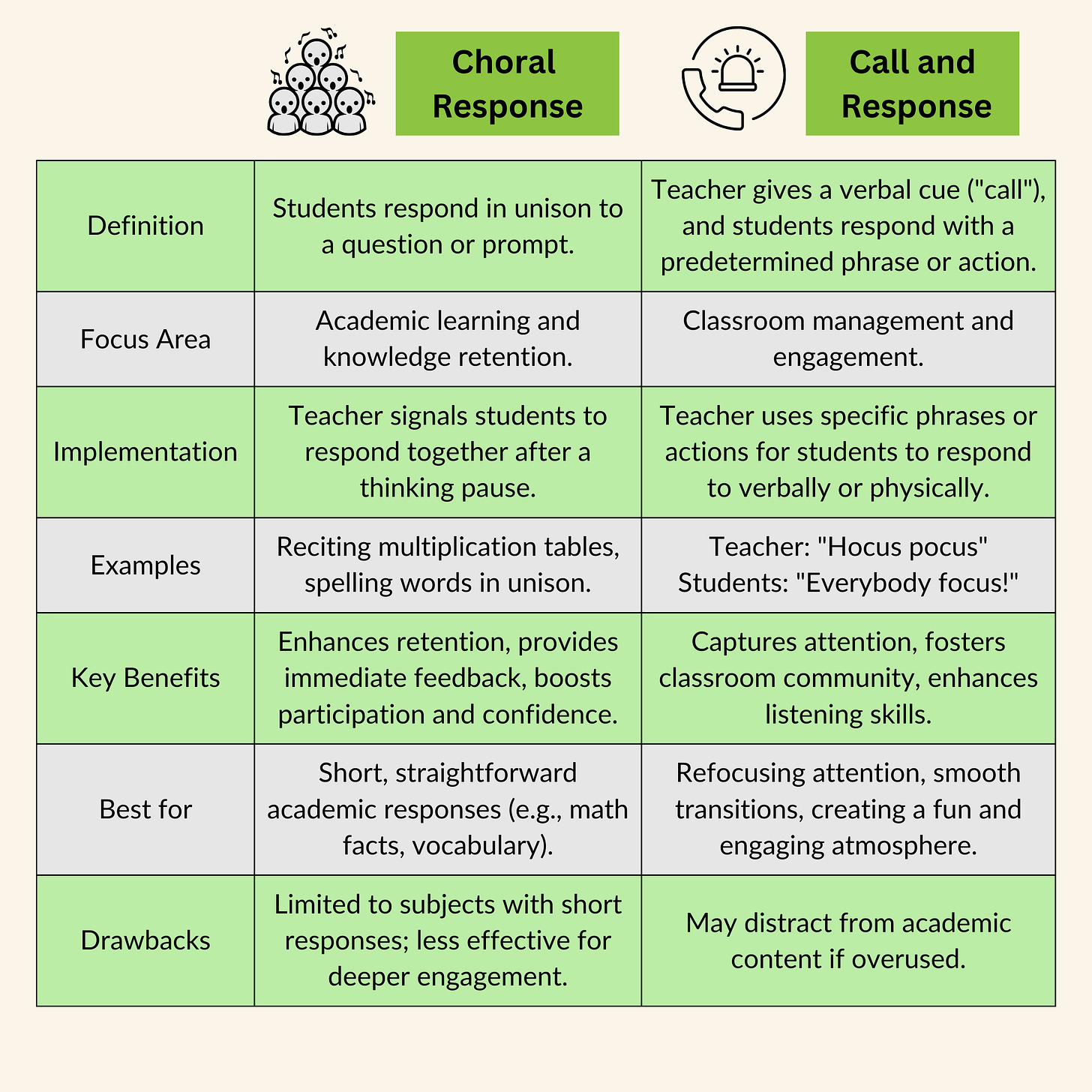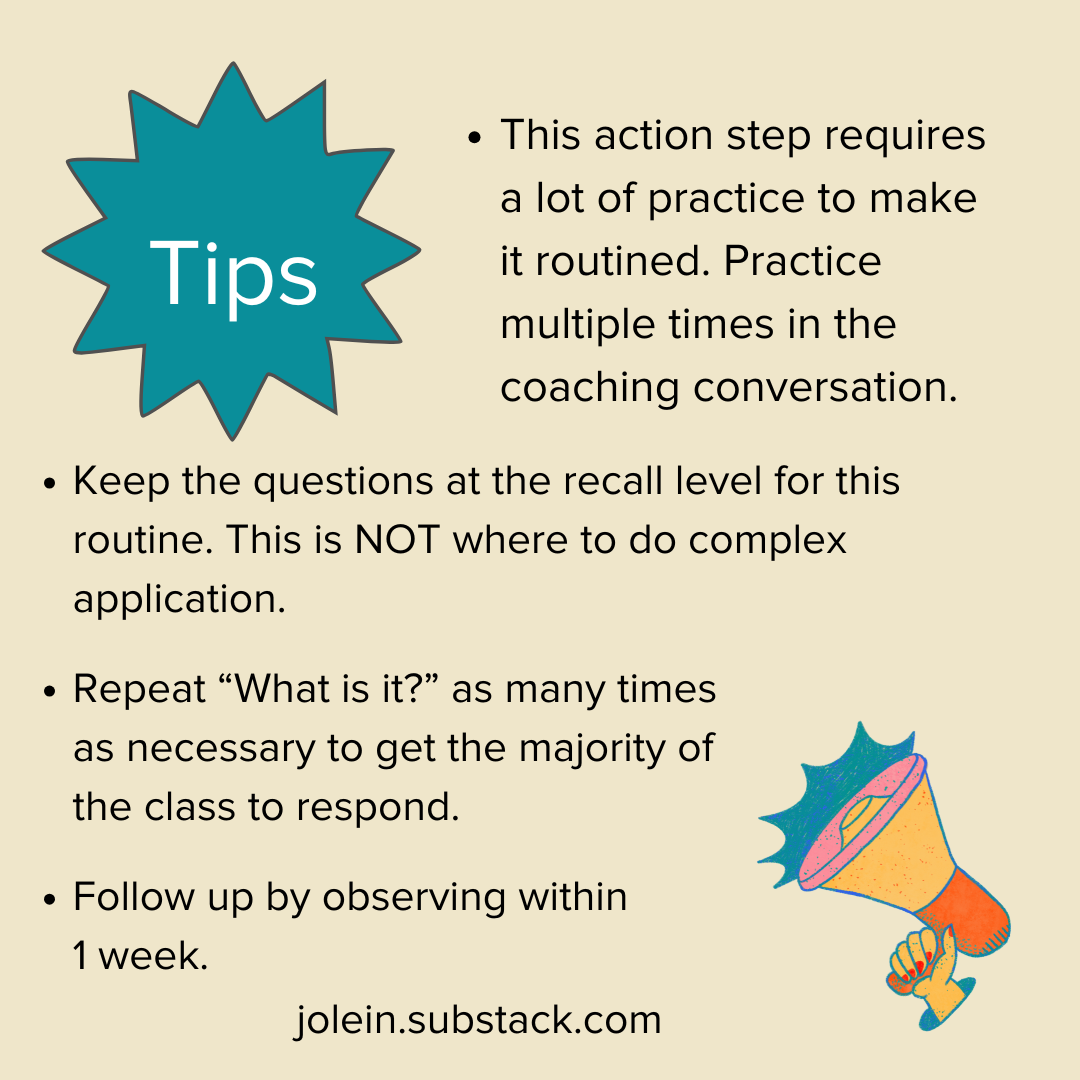Action Step of the Week: Call and Response Question
Stamp some key vocabulary to make it stick (great for multilingual learners)
Action Step of the Week
Every time a student gets a correct answer that’s a vocabulary word, stamp the correct answer using call and response:
Ask word for a given definition
Repeat the student’s given answer
“Class, what is it?” (give nonverbal cue) x2
Repeat the full definition with the word (“the word for <definition> is <word>.”).
Why?
Stamping academic vocabulary using call and response is valuable because it reinforces critical language skills, enhances engagement, and creates memorable learning moments.
1. Active Engagement Enhances Retention
2. Hearing Vocabulary in Context Builds Language Proficiency
Listening to the teacher's "call" models accurate pronunciation, tone, and cadence for the vocabulary. This exposure is crucial for multilingual learners to develop proper articulation and understand nuanced language patterns.
Repetition is a cornerstone of language acquisition.
Repeated exposure to the vocabulary within varied contexts ensures that students begin to associate words with their meanings and applications, an essential step in moving vocabulary from short-term to long-term memory.
3. Fosters Confidence in Speaking
Speaking in unison reduces the fear of making mistakes because no single student is singled out.
Over time, this confidence translates to improved fluency and a willingness to participate more actively in discussions.
5. Makes Learning Fun and Memorable
Integrating rhythm, movement, or gestures with call and response can make vocabulary practice enjoyable and memorable.
I hate semantics in education. While there are subtle differences, it is most important that you know what you are talking about when you say call-and-response vs. choral response.
Note: Call and response can be academic. Take a look at anything from Whole Brain Teaching.
Choral response:
Call and response that included ACADEMIC content (check out this whole playlist)
Potential Evidence
Language acquisition is low in the classroom (multilingual learner population)
Energy or participation is low
The answer gets lost in the questions; students struggle to recall vocabulary.
Questions to Ask Yourself
How many students do you hear or see evidence from?
What are the students’ level of engagement? Do you see evidence of eye contact, text reading, participation, etc.?
To what extent can students verbally say the vocabulary words?
How many students can correctly define key vocabulary?
What is the energy of the room?
Glossary of Terms
Call: The verbal cue or prompt initiated by the teacher to elicit a specific response from students. Example: Teacher says, "All set?"
Response: The predetermined verbal, physical, or rhythmic reply given by students in unison to the teacher’s call. Example: Students respond, "You bet!"
Cue: A signal (verbal, visual, or physical) that indicates when students should respond. Example: Raising a hand or clapping to signal the start of the response.
Echo Response: A form of response where students repeat the exact words or sounds of the teacher’s call. Example: Teacher says, "Energy!" and students repeat, "Energy!"
Choral Response: Similar to call and response, but involves all students responding simultaneously without a call or direct cue, often used to practice factual content. Example: Teacher asks, "What’s 3 times 5?" Students say, "Fifteen!"
Attention Getter: A type of call and response specifically designed to redirect or focus students' attention. Example: Teacher: "Class, class!" Students: "Yes, yes!"
Signal Word: A specific word within the call that cues students to respond or act.
Coaching Conversation Template
How to use it:
Find any bracketed text.
Use only ONE of the evidence examples.
Plan and internalize this.
We want our teachers to internalize their lesson. This coaching plan is your lesson plan. Don’t be a hypocrite.
Be you! You can do it.
Praise/Follow Up on Previous Action Steps
I appreciate the opportunity to sit down with you to discuss my observation.
First, I want to follow up on <previous action step or feedback>. Tell me more about how this is going for you. What impact has this had on you and your students?
Today, I saw <positive evidence of specific teacher action>.
What impact does this move have on you and your students?
<Confirm their analysis - back it up with student-level evidence>
Evidence
I want to hone in on some evidence that I collected.
<poor language acquisition> (i.e. I had the privilege of looking at the WIDA data and I noticed a pattern. As you look at this data, what do you notice about the trends? Let’s take a look at the WIDA proficiency descriptors. To move up on these descriptors and address the trends in the data, we are going to focus on a vocabulary routine. How does that sound?)
<low participation/energy> (i.e. I observed your class from 12:02 to 12:22, which was primarily the vocabulary section. In that time, you leveraged a few participation techniques. Namely, I saw you ask for hands 4 times, and you cold-called 2 times. Of the 25 students, 5 were actively participating orally. How did the energy in the room feel to you?)
<lost answers> (i.e. I want to highlight your discussion of the word “rebellious.” You students struggled to answer the questions at first and you distinguish between this word and others on the list. Then, you moved on to the next word. When I asked students later to define “rebellious,” 1 out of the 5 students I asked couldn’t define it. I want to back it up to the discussion and give you a quick technique to help stamp vocabulary words.)
Action Step
Great, so here is your action step: Every time a student gets a correct answer that’s a vocabulary word, stamp the correct answer using call and response:
Ask word for a given definition
Repeat the student’s given answer
“Class, what is it?” (give nonverbal cue) x2
Repeat the full definition with the word (“the word for <definition> is <word>.”).
What impact will this have on you and your classroom?
Go ahead and write down the action step.
Plan/Practice
Let me show you what this looks like with the observed lesson.
MODEL
I’m in the vocabulary section of my lesson. Now, I am going to pose <basic recall definition question>.
“<Word>.”
Class, what is it? “<Word>.”
What is it? “<Word>.”
The word for <definition> is <word>.
What did you see in my model that is present in the action step?
PLAN
Let’s look at a word that you want to practice this with. Write down your question to elicit that word and get ready to role play.
PRACTICE
Pose your quetion and lead us in stamping the definition.
Look for:
Formal register; tone is firm, language is formal
Question elicits the word
Repeats “what is it?” at least twice
Stamps the definition and word
What impact will this type of call and response have on your classroom?
Closing/Follow-Up Up
Thanks for playing along. Practice can be awkward, but it is a great way to ensure we can work out all the kinks.
Let’s review the action step.
I would love to see this in action as a follow-up. I look forward to seeing you in action <date>.
Further Readings:
‘Chapter 6: Questioning’, in Allison, S. and Tharby, A., 2017. Making Every Lesson Count. Carmarthen: Crown House.
Lemov, D., 2015. Teach Like A Champion 2.0. 2nd ed. San Francisco: Jossey-Bass.






Fantastic insight into the science of call and response, including the importance of repetition. I’ll say it again. Fantastic insight into the science of call and response, including the importance of repetition.
Sorry. Had to.